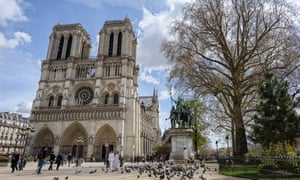Hello Everyone:
Good Tuesday afternoon, this is Yours Truly coming to you on a rather gray day in the blogosphere. This has been a fascinating 24 hours, following the fire at Notre Dame Cathedral in Paris, France. Blogger is particularly interested in the a conversation thread that has evolved in the aftermath of the blaze: the role of houses of worship in contemporary society.
 |
| Notre Dame Cathedral Paris, France theguardian.com |
There was a group of pious that objected to the excessive spending on the construction and decorative program of these lavish buildings but they were in the minority. The dominant sentiment was great energy, ambition, and a real desire to create the greatest monument to God's glory (durhamworldheritagesite.com; date accessed Apr. 16, 2019). What about your local house of worship? Do religious communities need a physical space to flourish?
 |
| Old Friendship Baptist Church Washington D.C. savingplaces.org |
The non-profit Sacred Spaces Conservancy (sacredspacesdc.org; date accessed Apr. 16, 2019) and researchers believe that houses of worship have ample spiritual and communal value, which makes their decline or destruction cause for alarm. Sacred Spaces reached the economic impact houses of worship on a local community, in this case, Washington D.C. While comprehensive in scope, the research does not engage or include how Americans define "sacred space," including people who considered meditation and volunteering as acts of faith and good works, even if it does not take place in a physical place (washingtonpost.com; Nov. 23, 2018; date access Apr. 16, 2019).
Noreen Bryant, the spokesperson for the National Community Church, told the Washington Post, "Evangelical Christians,"
see that part of who we believe Jesus is was incarnate, so he came and moved into the neighborhood, You don't need a [church] building to do that,...(Ibid)
In short, the modern day answer is no, a physical space is not necessary to perform acts of faith and good works. If a physical building is not necessary, than what about religious symbols?
 |
| Grand Synagogue Paris, France sandiegofreepress.org |
In the United States, you can walk down any street and see people wearing all sorts of religious attire as a form of outward expression of devotion. France frowns on visible religious symbols. On March 3, 2004, the French Senate approved a bill prohibiting the wearing of conspicuous religious symbols in public schools (brookings.edu; Mar. 1, 2004; date accessed Apr. 16, 2019). The law is a narrowly defined reassertion of religious neutrality within French public schools (Ibid). The law was roundly condemned in the United States because it is common to see American school children walking the halls with crosses, head scarves, and kippot (Jewish skull caps). The ban on visible religious symbols in French schools is a manifestation of French views of religious freedom.
French and Americans hold opposite opinions on what constitutes religious freedom. One way to understand this divergence of views are two bills that were approved by the U.S. Congress and the French government in 1998 with opposite goals. The United States passed the International Religious Freedom Act, which imposes sanctions on countries that were convicted of violating religious freedom. Coincidentally the very next day the National Assembly recommended the creation of a government task force, the Inter-Ministerial Missions against Sects, to monitor dangerous cults (Ibid; July 1, 2001). Paradoxically, both countries embrace religious freedom, embedding it in their respective constitutional documents. Neither country recognizes nor subsidizes an official religion, however Catholicism is still the primary religion in France along with Islam, Protestantism and Judaism (Ibid), Herein lies the problem, if France is a nominally secular country, why has there been such an outpouring of emotion in the 24 hours since the fire at Notre Dame?
Perhaps the best answer to that question comes from historic preservation. One of the reasons historic preservationists do what they do is that buildings are testament of a moment in history and a record of a civilization at that particular moment. Notre Dame is symbolic of Christianity in France, built at time when the Catholicism was the center of everyday existence. The cathedrals and churches were the center of daily communal life. It was a difficult relationship, bishops and cardinals lived like aristocracy while the average person had scratch a meager existence. Over time, Notre Dame became an integral part of France's historic-cultural life. Even if you were a lapsed Catholic or not Catholic, you understood the significance of the Cathedral as the epicenter of Christian France.
Blogger would be remiss in not addressing some of the comments, on the social media, regarding the destruction of black churches and mosques. Last week three churches and a mosque were burnt to the ground. These houses of worship matter as much as the bold faced places because they are important to the life and history of their communities. Black churches and mosques serve as places of regular worship and platforms for social justice. Their loss is mourned in the shadows of the loss of more bold faced places. We should not forget them. We should not forget all the synagogues, Protestant churches, and mosques destroyed by the Catholic Church in the name of heresy.
As firefighter put out the smoking embers and investigate the cause of the Notre Dame fire, perhaps it can finally motivate people to honestly discuss the role of religion in contemporary society.
No comments:
Post a Comment